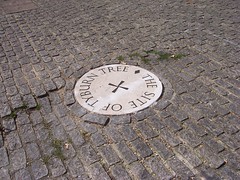
Traduzione by DANILA FORESTI, volontaria di English Gratis. Il testo originale è tratto da una pagina del sito inglese di Wikipedia ed è disponibile nel rispetto della licenza Creative Commons Attribution 2.5 ![]() photo credit: Loz Flowers
photo credit: Loz Flowers

Tyburn (1)
Tyburn (1)
Tyburn was a village in the county of Middlesex close to the current location of Marble Arch in present-day London.
Tyburn era un villaggio della Contea del Middlesex, vicino all’attuale ubicazione di Marble Arch nella Londra di oggi.
It took its name from the Tyburn or Teo Bourne ‘boundary stream’, a tributary of the River Thames which is now completely covered over between its source and its outfall into the Thames.
Esso prese nome dal Tyburn o Teo Bourne “corso d’acqua di confine”, un affluente del fiume Tamigi, ora completamente coperto tra la sua sorgente e la sua foce nel Tamigi appunto.
The name was almost universally used in literature to refer to the notorious and uniquely designed gallows, used for centuries as the primary location of the execution of London criminals.
Il nome Tyburn, in letteratura, è stato quasi universalmente utilizzato per far riferimento al notorio ed unico, siffatto patibolo, usato per secoli come principale luogo per le esecuzioni dei criminali di Londra.
History
Storia
The village was one of two manors of the parish of Marylebone, which was itself named after the stream, St Marylebone being a contraction of St Mary’s church by the bourne.
Il villaggio consisteva in uno dei due feudi del distretto parrocchiale di Marylebone, che a sua volta aveva preso il nome dal torrente, essendo St. Marylebone una contrazione di “Chiesa di Santa Maria sul Bourne”.
Tyburn was recorded in the Domesday Book (letteralmente Libro del Giorno del Giudizio) and stood approximately at the west end of what is now Oxford Street at the junction of two Roman roads.
Il borgo di Tyburn fu registrato nel Domesday Book (censimento realizzato sotto Guglielmo il Conquistatore nel 1086-1087) ed era situato, approssimativamente, all’estremità occidentale di quella che adesso è Oxford Street, all’incrocio di due strade romane.
>>> The predecessors of Oxford Street and Park Lane were roads leading to the village, then called Tyburn Road and Tyburn Lane respectively.
Le antenate di Oxford Street e Park Lane erano strade che conducevano al villaggio e, a quei tempi, erano denominate rispettivamente Tyburn Road e Tyburn Lane.
In the 1230s and 1240s the village of Tyburn was held by Gilbert de Sandford, the son of John de Sandford who had been the Chamberlain of Queen Eleanor.
Negli anni 1230 e 1240 il villaggio era sotto il dominio di Gilbert di Sandford, figlio di Giovanni di Sandford, il quale era stato Ciamberlano della Regina Eleonora.
Eleanor had been the wife of King Henry II who encouraged her sons Henry and Richard to rebel against her husband, King Henry.
La Regina Eleonora, che era stata la moglie di re Enrico II, incoraggiò i figli Enrico il Giovane e Riccardo ad insorgere contro il consorte stesso, Re Enrico.
In 1236 the city of London contracted with Sir Gilbert to draw water from Tyburn Springs, which he held, to serve as the source of the first piped water supply for the city.
Nel 1236 la città di Londra stipulò un contratto con Sir Gilbert per attingere acqua dalle Sorgenti del Tyburn, che lui deteneva, da utilizzare come risorsa per i primi rifornimenti di acqua corrente alla cittadinanza.
The water was supplied in lead pipes that ran from where Bond Street Station stands today, half a mile east of Hyde Park, down to the hamlet of Charing (Charing Cross), along Fleet Street and over the Fleet Bridge, climbing Ludgate Hill (by gravitational pressure) to a public conduit at Cheapside.
L’acqua veniva distribuita mediante condutture in piombo che si snodavano da dove si trova attualmente la Stazione di Bond Street, mezzo miglio ad est di Hyde Park, fino al borgo di Charing (Charing Cross), lungo Fleet Street ed oltre Fleet Bridge, ascendendo Ludgate Hill (grazie alla pressione gravitazionale) per raggiungere un pubblico condotto in località Cheapside.
Water was supplied for free to all comers.
L’acqua veniva erogata gratuitamente a tutti colore che ne facevano uso.
Tyburn had significance from ancient times and was marked by a monument known as Oswulf’s Stone, which gave its name to the Ossulstone Hundred of Middlesex.
Tyburn ebbe prestigio già dai tempi antichi e fu caratterizzata da un monumento conosciuto come Oswulf’s Stone (un megalito pre-romano) che, a sua volta, diede il nome al Cento (suddivisione della contea) di Ossulstone -Middlesex.
The stone was covered over in 1851 when Marble Arch was moved to the area, but it was shortly afterwards unearthed and propped up against the Arch. It has not been seen since 1869.
La pietra è stata coperta nel 1851, quando Marble Arch fu spostato in quell’area, ma venne poco dopo riportata alla luce ed eretta contro l’Arco. Dal 1869 non è più rintracciabile.
(continua)

